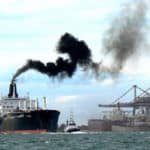Ammonia Trade Flows About to Blow Up

Demand for seaborne transportation of ammonia is about to blow up in the coming years. In its latest weekly report, shipbroker Intermodal said that “traditionally used in fertilizer production and as a component in chemicals and explosives, ammonia is now gaining attention due to its low-carbon properties which make it an attractive option for co-firing in power plants and as a feasible alternative fuel in the shipping industry”.

Source: Intermodal
According to Intermodal’s Research Analyst, Ms. Chara Georgousi, “the global trade of low-carbon ammonia is expected to witness a significant surge, reaching around 69 million tonnes by 2040. On the demand side, East Asia, with Japan and South Korea at the forefront, is expected to emerge as the largest importer of low-carbon ammonia, driven by their decarbonization initiatives. At the same time, Europe is forecast to follow as the second-largest import region. On the supply side, the Middle East and Australia are emerging as major exporters, contributing more than 65% to the global trade volume. While the Middle East is poised to become Europe’s primary supplier, Australia is set to become the world’s largest exporter and key supplier of East and SE Asia”.

Ms. Georgousi said that “demand is to be transformed by increasing move from fertiliser production to bunkers. Against this backdrop, the global seaborne ammonia trade exhibits signs of steady growth in the coming years, reflecting the increasing global focus on ammonia as a key player in the energy and agricultural sectors, along with its emerging role in decarbonization efforts and as a potential alternative fuel source. More specifically, in 2023, it experienced a y-o-y growth of 2.9%, showing a healthy increase in global demand and supply dynamics. This upward trajectory is anticipated to persist through 2024 and 2025, with forecasts indicating an annual growth rate of approximately 4%”.

Source: Intermodal
Intermodal’s analyst also noted that “ammonia, known for its toxicity and corrosiveness, is typically transported using Large and Medium Gas Carriers. These ships are equipped with advanced containment systems to handle the transportation of ammonia in its liquefied form. Going forward, with a surge in demand for green ammonia as both a bunker fuel and a power generation resource, there’s an increasing demand for specialized vessels like VLACs. The existing orderbook for VLACs includes 36 vessels, with a significant 83% being constructed by South Korean shipbuilders who leverage their experience in LNG and gas carriers. The VLACs on order are expected to have advanced designs, incorporating dual-fuel propulsion engines and energy-saving features. The delivery of these vessels is expected to begin in late 2026 and will peak in 2027 when 28 vessels will enter the fleet, aligning with the anticipated increase in demand for ammonia transport and usage. Over the next 25 years, the projected requirements for the seaborne transportation of green and blue ammonia suggest a need for up to 400 vessels. Additionally, the maritime industry is actively exploring ways to adapt LNG carriers for ammonia transportation, catering to the growing need for this cleaner energy source. Indeed, according to Lloyd’s Register projections, from 2030 onwards, LNG newbuildings will feature innovative tank and cargo containment systems adaptable for ammonia carriage, to maintain regulatory compliance and operational versatility”, Ms. Georgousi concluded.
Nikos Roussanoglou, Hellenic Shipping News Worldwide
Source link
